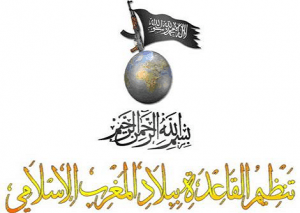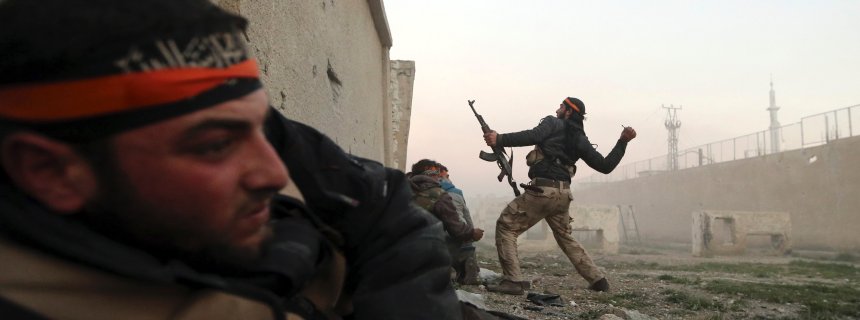Institute for Contemporary Affairs
Founded jointly with the Wechsler Family Foundation
Vol. 15, No. 1 January 13, 2015
- Syria and Iraq have become the epicenter of the global jihad. Thousands of jihadists originating from 81 different nationalities have flocked to Syria and Iraq to be part of the battle against the Assad regime and the Shiite regime in Iraq.
- Most of North Africa’s jihadist groups were hesitant to associate themselves with the Islamic State until the United States commenced its military intervention in Iraq and Syria in August 2014.
- North African fighters receive a monthly salary of $2,000-3,000. Hundreds of the North African fighters were killed in battle. By November 2014, 219 Moroccans had died in Syria and 32 in Iraq including 20 in suicide attacks. About 500 Tunisians died in combat.
- A contingent of fighters succeeded to make its way back to the three North African countries. The North African jihadist contribution to the Islamic State has already had an impact on the stability of the three North African regimes. It is clear that if the regimes do not oppose these trends, the jihadist effect could dominate the politics of each of these three countries and create a situation unprecedented in the area.

Never in the modern history of the Muslim world has a conflict drawn so many jihadists as is the case with the Syrian and Iraqi civil wars, surpassing wars in Afghanistan in 2001, Iraq in 2003. Indeed since the outburst of the conflict in Syria in 2011 and the 2014 takeover of Mosul by ISIS (Islamic State in Iraq and Sham), now IS (the Islamic State), Syria and Iraq have become the epicenter of the Global jihad. Thousands of jihadists originating from 81 different nationalities have flocked to Syria and Iraq to be part of the battle against the Assad regime and the Shiite regime in Iraq assisted by Hizbullah and Iran and to participate in the establishment of an Islamic caliphate to rule the world after the defeat in battle of the Western powers and their local Arab allies.
Out of the thousands who volunteered for jihad about 5,000 fighters, originating from North African countries, have joined the ranks of IS and the Jabhat al-Nusra fundamentalist organizations active in Syria and Iraq. The biggest contingent is composed of Tunisians (3,000), followed by Moroccans (1,500) and Algerians (500-800). These numbers exclude the European fighters of North African origin (mostly from France and Belgium) who are estimated at almost 1,500-2,000 volunteers.
Oddly enough, the Tunisians comprise the largest contingent to the jihadist efforts in Syria and Iraq, followed by the Saudis (2,500) and the Libyans. All in all, the North Africans who have joined the militants in the fight against the regimes in Syria and Iraq represent roughly 50 percent of the foreign fighters. Ironically, most of North Africa’s jihadist groups were hesitant to associate themselves with the Islamic State until the United States commenced its military intervention in Iraq and Syria in August 2014. Jihadists such as Abdel Malek Droukdel from AQIM (Al-Qaeda in the Islamic Maghreb), Mohammed Zahawi , from Libya’s Ansar al-Sharia, and Mokhtar Belmokhtar from al-Mourabitoun, who fought alongside Bin Laden and Ayman al-Zawahiri, had refused, sometimes openly, to pledge allegiance to the Islamic State — even after it captured swathes of territory in Iraq in June 2014 and declared a caliphate. Recently however, North Africa’s younger jihadist generation has become emboldened to break away from al Qaeda’s, seeking instead to join Baghdadi’s caliphate in order to benefit from its success and wealth. Rather than deterring these groups, the U.S.-led coalition’s sporadic airstrikes in Iraq and Syria seem to have afforded the Islamic State with even more legitimacy in the eyes of North Africa’s jihadists.1
According to Mohammad Yassine el-Mansouri , the Moroccan Head of External Intelligence (DGED- Direction Generale des Etudes et de la Documentation), there are 500 potential militants striving to reach their compatriots in Syria. Furthermore, Mansouri disclosed to the UN Security Council Committee on Counter-Terrorism on September 30, 2014 that some of the Moroccan militants are filling senior positions in the Islamic State: some of them are “Emirs,” ministers (Justice, Finance, Interior), as well as a Military Emir (military Chief) and even the head of a geographical region (the Turkman Mountain). However, according to a Moroccan journalist who visited the Islamic State, the bulk of the Moroccan jihadists are rank and file members in the Islamic state. Seventy five percent of them are “Inghimasiyyine,” an Islamic State terminology for an undercover operative responsible for protecting convoys and to serve as the second wave of attack when an offensive mission or targeted attack is carried out.2

During the first days of the civil war in Syria, the North Africans were organized in brigades, one of which was named “Sham al-Islam” and headed by a Moroccan, Ibrahim Benchekroun, alias Abu Ahmad EL-Maghrebi. Some even nicknamed the brigade as the “Liwa al Infransiyyoun” (the French Brigade since the combatants communicated among themselves in French; some of its members were French nationals, mostly of North African origins, who were integrated in the North African French-speaking brigade. The ill-fated brigade that was active in the Latakia region was almost annihilated by the Syrian army loyal to Bashar Assad. The remaining members were scattered in different units created since then by the Islamic State.3
The same sources disclosed that a few hundred of the North African fighters were killed in battle. By November 2014, 219 Moroccans had died in Syria and 32 in Iraq, including 20 in suicide attacks. About 500 Tunisians died in combat. A contingent succeeded to make its way back to the three North African countries (the Tunisians report the return of 500 fighters). Some have been apprehended by the authorities, tried and sentenced to years of imprisonment in their country of origin.4
Considered by the Islamic state as “Mouhajiroun” (immigrants), the North African fighters receive a monthly salary of $2,000-3,000 (compared to $500 paid to the local fighters). If married, the volunteer receives an additional $200 and $50 more for each of his children. A new born child will automatically generate a “bonus.”5
There is no doubt that satellite channels, social networks and the Internet helped speed the mobilization by exposing the humanitarian catastrophe in Syria. The jihadist propagandists created an atmosphere of solidarity with the Syrian people in such a way that an environment was created to recruit fighters, whether civilians or jihadists. After hearing the call for foreign jihad from the mosque, TV or the Internet, young people would volunteer through a clandestine network from different Maghreb (North African) countries to fight alongside organized groups in Syria. Even young Maghreb women are being drawn into the conflict in the wake of a fatwa from a Wahhabi cleric. Saudi Sheikh Mohamed al-Arifi allegedly ruled it was permissible for Islamist fighters to marry girls as young as 14 for a few hours. While al-Arifi has denied being behind the fatwa, it has still been used to take advantage of young women.6
Multiple Motives for North African Jihadists
Why are so many North African jihadists heading to the Syrian and Iraqi battlefronts? What stands behind this massive mobilization and readiness of young people to leave everything behind, cut their ties with family, disappear from their milieu without any announcement, smuggle themselves to the Syrian or Iraqi arenas (at great risk from their respective countries and under the constant watch of the security and intelligence agencies that monitor movements to and from the Middle East), and of course to be ready to sacrifice their lives for a cause fought thousands of kilometers away from their native North African country.7
The explanation may be found in the following:
a. North Africans have always wanted to be close to the “core” of the Middle East, feeling marginalized by historical events taking place in the Arab-Israeli conflict away from their region. North African states sent expeditionary troops to the Middle East after the 1967 Six-Day War to take part in the battle against Israel. Morocco sent two brigades (one was deployed in the Syrian Golan Heights and one in Egypt) while Algeria sent a brigade to Egypt . Those troops were actively engaged in combat during the Yom Kippur 1973 war against Israel and suffered great losses.
b. North Africa is the setting for developing jihadist movements partly inspired by the war in Afghanistan and by the Khomeini revolution in Iran. But the unsatisfied needs of young, mostly unemployed people, left behind by the process of modernization and westernization and unwilling to accept the reality of power also plays a role. The disintegration of Libya after Qaddafi and the takeover of the country by jihadist militias have served as a contagious example to North African jihadists, meaning that what has been achieved in nearby Libya by jihadists could be repeated in Tunisia, Morocco and Algeria.
c. The North Africa states have been exposed for a long time to Wahhabi proselytism8 which is by essence opposed to the “moderate” Sufi Islam practiced in North Africa. Morocco and Tunisia were tolerant to the Wahhabi theological invasion while Algeria chose to fight it by all means. Identification with the Wahhabi ideology is only one step from joining soul mates to fight the “heretics” leading “heretic” regimes. Oddly enough, northern Morocco which seems to be the area that has drawn the most jihadists to the Islamic State is a region were strict Salafi Sheiks dominate the religious scene and do identify openly with the ideology of the Islamic State and its targets.
d. There is also an economic factor one cannot ignore. Most of the Moroccans who have joined the Islamic State come from the north of the country that has been neglected by former King Hassan II. The northern region of Morocco is hit by severe unemployment and subsequently by radicalization. The fact that the Islamic State pays salaries that cannot even be imagined in Morocco is definitely a factor in the enrollment of jihadists by the Islamic State.9
f. Finally, one cannot under estimate the geographic factor: North Africa is very close to southern Europe and the jihadist network existing there, which makes coordination and recruitment easier. Those networks appeared first during the second Iraqi war (2003) when people thought it acceptable to travel to Iraq and join the fight against the “American aggressor.”
Facing this phenomenon, the three North African countries made the decision to fight the jihadist trends that endanger their respective regimes by enforcing “exceptional and emergency” laws and anti-terrorist legislation. The main concern stems from the fact that those surviving jihadists return with military experience in weapons use and expertise in making explosives and booby trap devices that could be used against the regimes. Morocco, Algeria and Tunisia have reinforced their intelligence cooperation with the United States and European anti-terrorist agencies, mainly with France and Spain. Algeria refused an American request to position attack drones on its soil.
As of today:
* Jihadist cells have always existed in Morocco and from time to time they carry out terrorist attacks against major targets in the Kingdom. Morocco is conducting a ruthless and merciless war against jihadist organizations while beefing up its defenses around strategic targets and institutions. Still, the Cherifian Kingdom has not succeeded in eradicating the jihadist organizations. According to the Moroccan Head of External Intelligence, the anti-terrorist agencies succeeded until October 2014 to foil 119 attacks with explosives, 109 assassination attempts, 7 attempts to kidnap hostages and 41 armed robberies.10
* Since the beginning of the 1990s, Algeria was the scene of a bloody and ugly war between the jihadists and the military regime. The war which lasted almost 10 years cost the lives of almost 200,000 people. Even though the Algerian regime had the upper hand and succeeded in pushing the jihadists to the southern borders facing the Sahara, it still did not quell the insurgency. The GIA (Groupe Islamique Arme) transformed itself by the mid-2000s into AQMI ( Al-Qaeda in the Islamic Maghreb), paying allegiance to Al-Qaeda, only to splinter in the years following the so-called “Arab Spring” into smaller organizations, some still linked to Al-Qaeda and others declaring their allegiance to the Caliph Ibrahim al-Baghdadi and the Islamic State.

It is no coincidence that the Algerian contingent to Syria is the smallest of the North African countries. The mighty military regime has been conducting an open war against jihadists using all possible means to put a stop to their activities,11 not always with success. The terrorist acts conducted in Algeria by the Mourabitoun organization headed by Mokhtar Belmokhtar in the beginning of 2014 are proof of the permeability of Algeria’s borders with Mali and also of the fact that the jihadist organizations are still very active. In 2013, Blemokhtar’s forces took 800 hostages in an Algerian refinery. In August 2014, a French tourist was kidnapped and subsequently beheaded in September by a group called “Soldiers of the Caliphate” which paid allegiance to the Islamic State. A few months later the head of the group, Abdelmalek Gouri, and two of his closest assistants were killed by the Algerian army.12
*Tunisia is certainly the weakest link in North Africa. Having a small and inefficient army with obsolete weapon systems,13 the Tunisian regime does not have the means to fight effectively against jihadist terrorism. Moreover, unlike its two neighbors in the west, jihadist organizations find sympathy and safe haven among a radicalized population fed up with the excesses of the Ben-Ali regime, its corrupted politicians and the “no hope” situation created by a crumbling economy. It is no accident that in Tunisia the call for jihad is the strongest, and it is the place with the highest response to the call of jihad. The Libyan “domino effect” has had its biggest impact in Tunisia.14 Moreover, Tunisian territory has become a transit route from Libya to the Sahara used for smuggling weapons, drugs and human traffic and to destabilize the Sub-Sahara zone. The Tunisian government is trying its best to stop the flow of jihadists to Syria. In June 2013, the Tunisian Interior Minister Lotfi Ben Jeddou disclosed that five networks specializing in getting Tunisian fighters to Syria were dismantled. About 1,000 young men were prevented from travelling.15
The North African jihadist contribution to the Islamic State has already had an impact on the stability of the three North African regimes. It is clear that if the regimes do not oppose these trends, the jihadist effect could dominate the politics of each of those three countries and create an unprecedented situation in the area. The fact that many splinter organizations in North Africa, Nigeria (Boko Haram) and Mali have sworn allegiance to the Islamic State crystallizes for the present rulers of North Africa the nature of the danger threatening their respective regimes. It is out of this fear that Morocco, Algeria and Tunisia are conducting their fight against extremism. In this respect it is quite obvious that neither of the three has an interest to see more jihadists from North Africa flocking in from Syria and Iraq.
In August 2014, Africa’s spy chiefs met in Nairobi as part of the African Union’s Committee of Intelligence and Security Services of Africa (CISSA). They expressed their deep concern about the growing threat of the Islamic State and the likelihood that the radical organization might influence the continent’s own jihadist groups. Areas of concern included “an alliance being built by terror groups worldwide, sophisticated sources of funding and (Africa’s) porous borders.16 This is the challenge: the question is whether the ruling governments will know how to address the threat.
* * *
Notes
1 http://www.huffingtonpost.com/daniel-nisman/time-to-take-sides-in-nor_b_5987932.html
2 Tarik Ben Larbi, Le maroc face a la “Daesh connection”, 24/11/14, Jeune Afrique, http://www.jeuneafrique.com/Article/JA2810p040.xml0/
3 idem
4 Siham Ali,Morocco: Thousands of Moroccan Jihadists in Syria, Iraq, Magharebia, http://magharebia.com/en_GB/articles/awi/features/2014/07/16/feature-02
5 Ben Larbi,op.cit.idem
6 Mawassi Lahcen, Maghreb Youth answer al-Qaeda call,08/03/13, Magharebia, http://magharebia.com/en_GB/articles/awi/reportage/2013/03/08/reportage-01
7 J.Tilouine, Maghreb: sur les routes du Jihad pour la Syrie ou l’Irak,29/7/14,Jeune Afrique, http://www.jeuneafrique.com/Article/JA2793p020.xml1/
8 idem; Tarik Ben Larbi, sup.cit.ibid.
9 idem.
10 Tarik Ben larbi, ibid.
11 Walid Ramzi, Algeria cracks down on Syria recruiting networks, 24/3/13, Magharebia, http://magharebia.com/en_GB/articles/awi/features/2013/04/24/feature-01
12 Le chef du Jund al-Khalifa tue, L’Express, 23/12/14, http://www.lexpress.fr/actualite/monde/proche-moyen-orient/le-chef-des-bourreaux-d-herve-gourdel-tue-par-l-algerie_1635163.html
13 Samy Ghorbal, Armee tunisiemnne: la grande desillusion, 2/9/14, Jeune Afrique, http://www.jeuneafrique.com/Article/JA2798p034-038.xml0/
14 S.Abba and others, Libye, Mali, Cameroun, Centrafrique… l’effet domino du terrorisme, 4/6/14, Jeune Afrique, http://www.jeuneafrique.com/Article/JA2785p034.xml0/
15 Jemal Oumar and Yasmine najjar, Al-Qaeda split could spell turmoil, 20/6/13, Magharebia, http://magharebia.com/en_GB/articles/awi/features/2013/06/20/feature-01
16 Hassan M. Abukar, Is ISIS allied to or influencing African Jihadi Groups?, http://africanarguments.org/2014/10/28/is-isis-allied-to-or-influencing-african-jihadi-groups-by-hassan-m-abukar/
– See more at: http://jcpa.org/article/north-african-fighters-in-the-syrian-and-iraqi-conflict/#sthash.SO4g1bUL.dpuf









